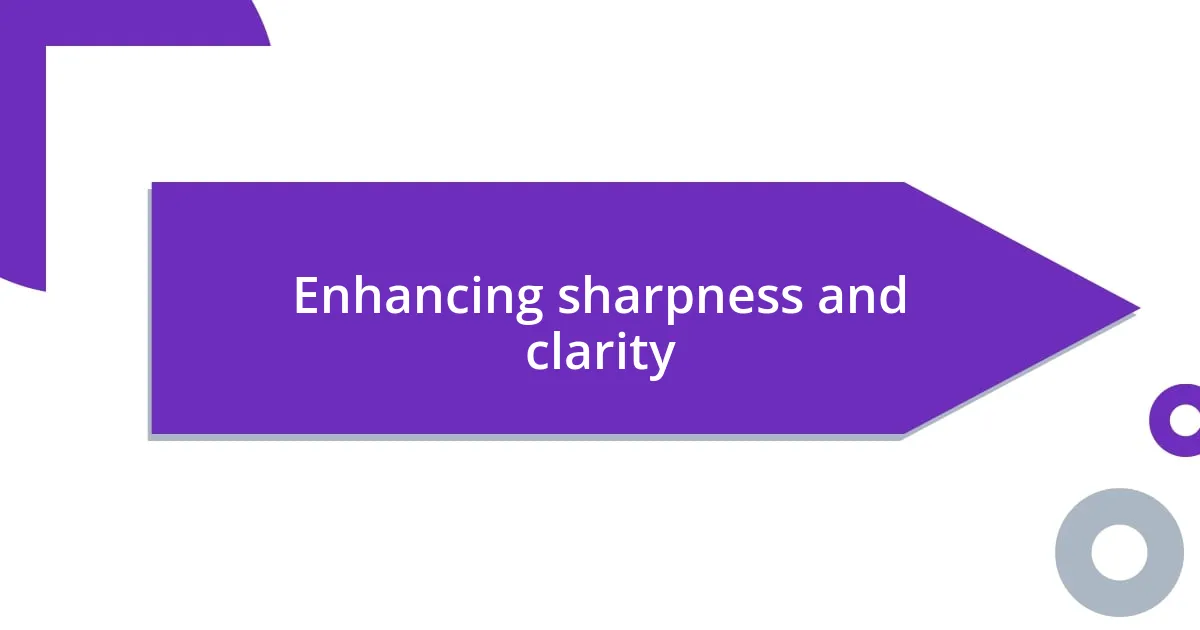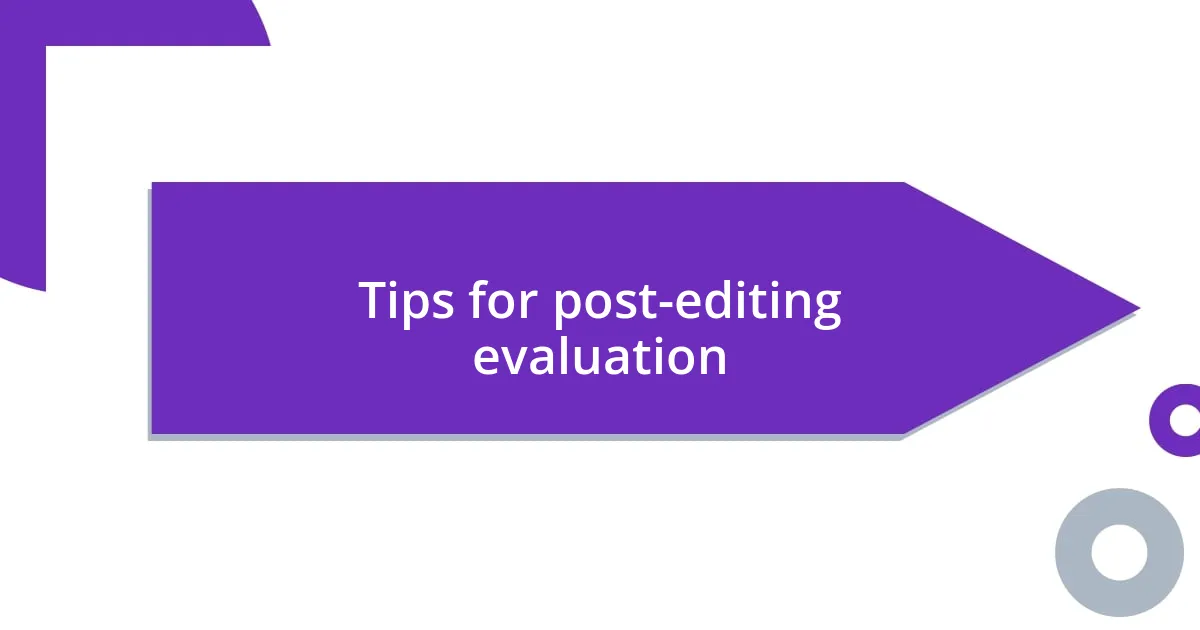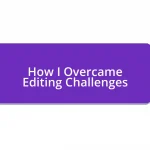Key takeaways:
- Choosing the right photo editing software significantly impacts your creative process; options like Adobe Lightroom and Photoshop cater to different editing needs.
- Key techniques such as cropping, adjusting exposure and contrast, and color balance are essential for elevating photo quality and resonance.
- Evaluating edits post-processing, seeking feedback, and revisiting photos after some time are crucial for refining editing skills and maintaining a fresh perspective.

Understanding photo editing tools
When it comes to photo editing tools, knowing the difference between software can make all the difference in your creative journey. I remember the first time I tried using a basic editor with limited capabilities; it was frustrating. My photos felt lackluster, and I couldn’t understand why—until I transitioned to more advanced tools like Adobe Lightroom. Suddenly, I was able to enhance lighting and color saturation in ways I never thought possible.
Navigating through various editing tools, from mobile apps to desktop programs, can be overwhelming. Have you ever felt paralyzed by choice? I certainly have. It was a revelation to discover that each tool serves distinct purposes. For instance, while Snapseed is user-friendly and great for quick edits, Photoshop became my go-to for serious retouching work.
Moreover, embrace the learning curve! Early on, I experimented with tutorials to master the basics. The first time I achieved the perfect contrast or removed an unwanted object seamlessly, I felt like a magic artist. Those small victories kept me motivated to explore further and discover even more powerful features in my editing toolkit.

Choosing the right editing software
Choosing the right editing software can feel like finding a needle in a haystack. I recall the excitement of testing various options, but also the frustration when things didn’t work as expected. I initially settled for free options, which was great for my budget, but as I developed my skills, I realized I needed software that could grow with me. This journey taught me that investing in quality tools often results in better outcomes.
Here’s a quick list to help you navigate your options:
- Adobe Lightroom: Ideal for photographers looking to enhance their images with powerful adjustments to light and color.
- Photoshop: Perfect for detailed retouching and intricate edits, allowing you to dive deep into creative possibilities.
- Canva: A user-friendly option for those who need quick edits and graphic design capabilities in one tool.
- Snapseed: Great for on-the-go edits and mobile users, it offers intuitive functions that make adjustments feel effortless.
As you explore these tools, remember the emotional connection tied to your images. Choosing software that resonates with your workflow is key to enjoying the editing process, fostering creativity, and improving your photography skills.

Key editing techniques for beginners
When diving into editing, a few key techniques can truly elevate your photos. One of the first things I learned was the importance of cropping. I remember a photo of a sunset that felt cluttered; once I cropped out unnecessary elements, the image’s beauty became much more pronounced. Proper cropping not only helps center your subject but also transforms how viewers engage with your images.
Next, don’t underestimate the power of adjusting exposure and contrast. I recall a gloomy day when I captured a beautiful landscape but felt it fell flat in the editing phase. By slightly brightening the exposure and increasing contrast, I was able to bring out the colors and depth in the scene that I felt in the moment. Little tweaks can dramatically enhance the mood of your photos, making them more engaging.
Finally, playing around with color balance can deliver stunning results. I often tinkered with the warmth of my images, which made a huge difference on those chilly winter shoots. It’s fascinating to note how a simple adjustment can change the entire vibe. I encourage you to explore these techniques—finding what works for you can be a rewarding journey in your editing adventure.
| Technique | Description |
|---|---|
| Cropping | Framing your subject for a clearer focus. |
| Exposure and Contrast | Enhancing light and depth to improve clarity. |
| Color Balance | Adjusting hues to evoke different emotions. |

Color correction and its importance
Color correction is one of those editing techniques I truly wish I had grasped earlier in my photography journey. I remember looking at my photos and feeling something was off, but I couldn’t quite put my finger on it. It wasn’t until I discovered how to adjust the color balance that everything clicked; transforming a dull, lifeless image into one that radiated warmth and vibrancy felt like magic. Have you ever noticed how the right colors can evoke strong emotions? It’s a powerful tool.
A significant part of color correction is understanding the mood you want to convey through your photos. For instance, I experimented with cooling down the tones in a photo I took at a winter festival, which perfectly captured the frosty atmosphere and invigorated the mood of the scene. This adjustment taught me that colors carry stories, and a simple tweak can amplify the narrative within an image. Isn’t it fascinating how a subtle change can lead to a completely different interpretation of an image?
In my experience, good color correction can elevate a mediocre shot into something breathtaking. I once edited a portrait where the skin tones were a bit too harsh. After adjusting the color slider, I found that the softer tones not only made the subject look more natural but also infused the photo with a warmth that was truly inviting. It felt rewarding to recognize this impact, and I encourage you to always keep an eye on how color can transform your work; it could be the difference between a photo that gets passed over and one that catches the viewer’s eye.

Enhancing sharpness and clarity
When it comes to enhancing sharpness and clarity, I found that sharpening is incredibly crucial. Many times, I’ve taken a beautiful shot that just didn’t have that crispness I desired. After experimenting with the sharpening tools in my editing software, I quickly realized how a little adjustment could bring out the finer details in a photo—like the delicate texture of leaves or the intricate patterns of a flower. Isn’t it amazing how sharpness can breathe life into your images?
Beyond sharpening, I often play with clarity settings to create depth. I remember editing a landscape where the foreground blurring made it hard to appreciate the beauty of the scene. By increasing the clarity just a notch, I experienced firsthand how it provided a more three-dimensional feel, giving the viewer’s eye a path to explore. It’s one of those simple tweaks that can make the world of difference, don’t you think?
Sometimes, I find that using noise reduction in tandem with sharpening can yield stunning results, especially in low-light situations. I once captured a night market scene that was vibrant but also grainy. By applying a gentle noise reduction, it not only made the colors pop but also allowed for a more enjoyable viewing experience. This balancing act taught me the importance of not just enhancing sharpness but also ensuring that the image retains its authenticity and charm. Wouldn’t you agree that striking that balance is key to powerful photography?

Using filters for creative effects
Using filters can be a game-changer for adding creative flair to my photos. I remember one evening, experimenting with a vintage filter on a sunset shot that initially felt lackluster. Instantly, the photo transformed, capturing the golden hues and creating an emotional, nostalgic vibe that transported me back to that magical moment. Isn’t it interesting how certain filters can encapsulate feelings so deeply?
I’ve often found that filters are not merely about altering colors; they can also set mood and atmosphere. For example, during a recent trip to a bustling market, I decided to apply a slightly faded filter to one of my candid shots. It evoked a sense of timelessness that resonated with my experience, making the chaos of the market feel warm and intimate. Have you ever had a photo that just needed a gentle touch to reveal its story?
Sometimes, I think about how straightforward it is to overdo filters, but the key is restraint. I recall an instance when I got carried away with multiple filters on a portrait. It ended up feeling artificial rather than artistic. This taught me an invaluable lesson: the most impactful edits often come from a delicate balance. I now approach filters as tools to enhance, not overshadow, the essence of the image—don’t you agree that subtlety often drives the strongest results?

Tips for post-editing evaluation
Evaluating your edits post-processing can be just as crucial as the editing itself. I remember the first time I went through my edited photos, and I was shocked by how many small details I overlooked. Taking a step back, I learned to scrutinize each image carefully, checking for inconsistencies or areas that still needed improvement. Have you ever found something in your edits that completely changes your perspective?
One tip I’ve adopted is to seek feedback from others. After sharing my edits with friends, I was often surprised by their observations. They sometimes catch things I didn’t see, like a distracting element in the background or a shadow that needed softening. Getting a fresh set of eyes can highlight aspects I might miss, reminding me that collaboration can enhance my work remarkably.
Finally, I encourage you to revisit your photos after some time has passed. I recall looking back at my edits a few weeks later and realizing I had grown in my editing style. What seemed perfect at first now felt overdone or misaligned with my current vision. Allowing time allows me to approach my work with fresh eyes, and I find it often leads to even greater edits. Isn’t it fascinating how our perspectives can evolve?














